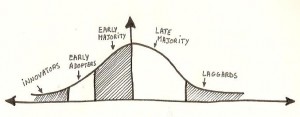The Role Of Social Proof At The Bottom Of The Pyramid: A Social CRM Perspective.
Diffusion of Innovations is a theory that explains how, why and the rate at which new ideas spread through groups of people. I won’t go into the technical details Everett Rogers posited in his works on the subject, but I will provide some of my observations on the opportunities now present on this side of Open Graph for social CRM. I shall distill these further in future posts over the next few weeks.
The Diffusion of Innovations theory states that there are five types of adopters in relation to innovations. Innovators, early adopters, early majority, late majority and laggards. Those who live at the bottom of the pyramid are the majority and this theory tries to explain what elements influence the movement of an idea from one group of adopters to the next. These elements are;
- Innovation – whatever it is being perceived as new
- Communication channels – how the message is moved
- Time – How long it takes for a decision to be made and how fast the whole thing spreads
- Social system – the different units (I call them people) working together to solve a common problem
Social System and Social Proof
All the elements are important but social system may be crucial at the bottom of the pyramid. BoP customers rarely make a ‘buy’ decision because the communication channel presented them with a compelling message. A number of considerations rise to the top really quickly when the customer is presented with an innovation. Among them are;
- What value does it really add? Perceived value has to be really high especially when a solution to their problem already exists and works satisfactorily well. Laundry detergent that smells like spring flowers also has to outperform the existing detergent when compared on number of washes delivered per kilogram (thanks Niti Bhan for this example, it’s burned in my memory 😀 ).
- Who else has used it and what are they saying about it? This is where social systems come in. The customer looks for others trying to solve the same problem as they are and having better success with this new idea. This is what is referred to as social proof and is located in the social system. It is probably most critical for the BoP customer (usually the majority, early or late) in making the decision to implement or not.
Social CRM at the BoP
So what does all this have to do with social CRM? Here are a few thoughts that I’ll be distilling a bit more over the coming weeks;
- Social proof now, in addition to offline communities, also lies on online social spaces.
- Facebook’s Open Graph now allows websites to display comments and ‘like’ data from Facebook related to a particular piece of content. For instance, if I like a shirt on paulfredrick.com, my friends can see my ‘like’. I could also add a comment about how much I liked the shirt’s fit and that I had ordered a few.
- A brand can present web site visitors, while they are on the site, with real-time information on which of their friends have made a purchase recently.
- If the site creates the functionality, users can recommend a shirt to a particular individual. If a good number of friends recommend the same shirt, a user maybe inclined to purchase because the social system has presented them with proof that they would look good in it. I think this is extremely interesting in this age of social commerce.
Mounting social proof in favor of a product or service would help businesses collapse the time it takes to move an idea or decision from innovators to late majority, in effect contributing to the transformation of the adoption S curve into an I curve as the late CK Prahalad describes in the book “Fortune at the Bottom of the Pyramid“.
With Facebook modifying the rules on how user data (specifically the UID) is used by third-party websites, I am now wondering what effect this will have on social commerce and informational social influence (aka social proof).
I would love to hear your thoughts on how organizations can use social CRM to grow their reach at the BoP as well as your thoughts on my thoughts 🙂
Updated 14.55 +3 UTC
Related posts:
